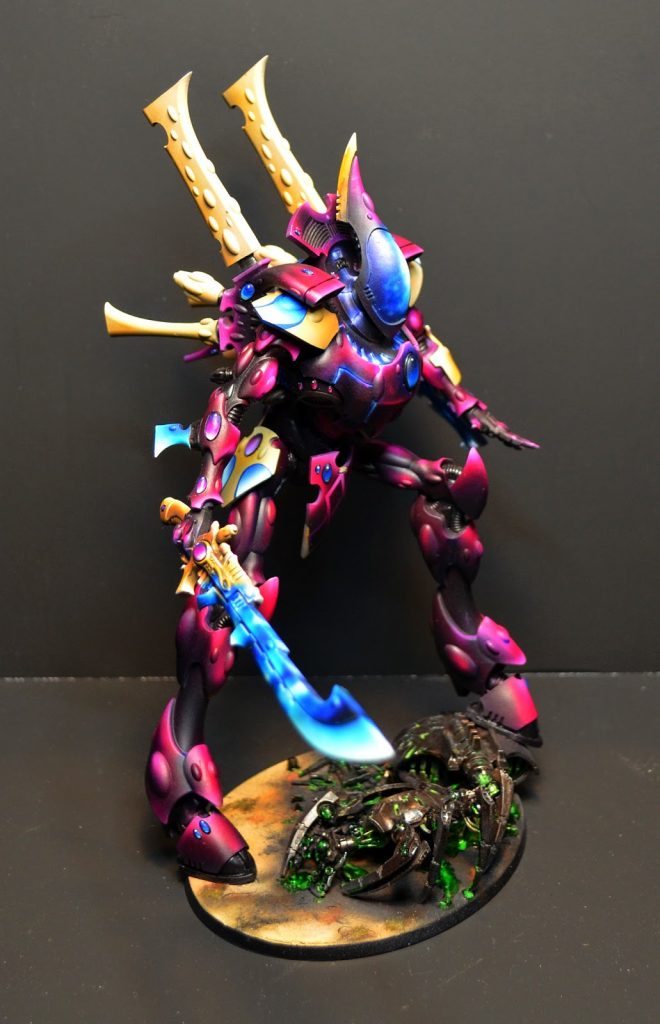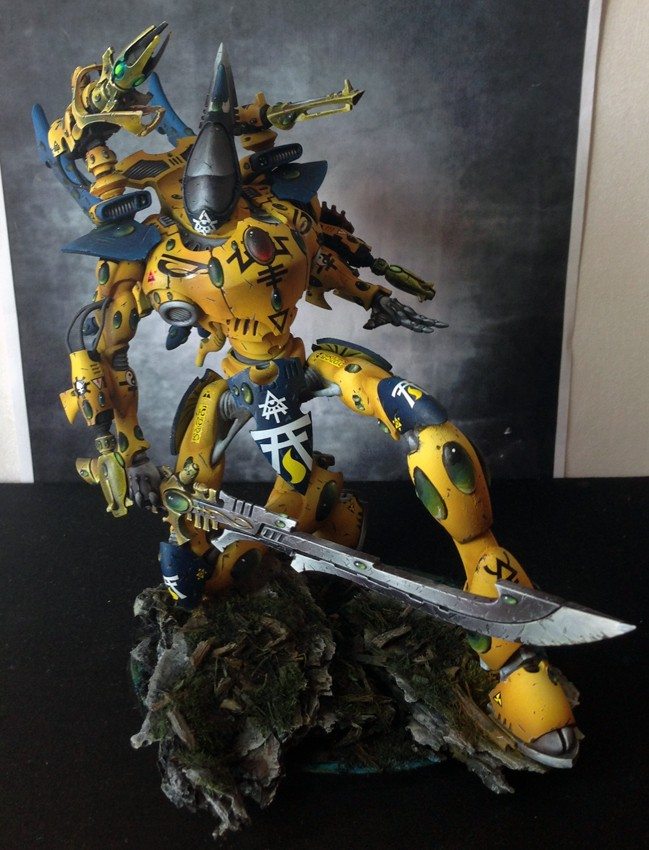It’s okay to use Wraithknights again, guys. They’re no longer the boogeymen of the game. Click to read the updated CA2018 article, or check out the Tactics Corner for more great reviews and strategies.
Overview
The Wraithknight is a towering titan of wraithbone and eldritch weaponry, animated by the spirit of a pair of Eldar twins- one living, one dead. Their psychic abilities amplified by their uncanny connection, the two pilots can reach across the barrier between worlds to control the massive bulk of their conveyance and wield it with a deftness of touch unthinkable to any other race.
On the table, a Wraithknight is indeed a rather massive beast, coming in with stats on par with those of any other superheavy. Strength and toughness eight make it a force to be reckoned with in combat as well as defensively, and twenty-four wounds mean that it won’t go down easily to even sustained firepower. A 3+ save isn’t particularly impressive, but it’s not particularly bad, either- it’s what Knights, Baneblades, etc, all get as well. A 12″ move is certainly pretty quick, although notably it has lost the ability to Fly that it possessed in previous editions, while weapon skill and ballistic skill 3+ are standard for Eldar- though they, like its movement, degrade as it takes damage. Finally, four attacks is a somewhat-unimpressive number, though its weapons can make up for this pretty well, so we can’t really complain too much. Clocking in somewhere between 375 and 450pts (depending on loadout), it is definitely rather expensive, but not much more so than most superheavies.
Wargear and Special Rules
A Wraithknight comes with Ancient Doom (allowing it to reroll misses against Slaanesh in close combat) as well as Catastrophic Collapse, potentially dealing damage to nearby units when it is destroyed. It also has the Unstoppable Revenant rule, allowing it to ignore the Heavy penalty, act normally after falling back, and pass over enemy infantry when doing so.
More interesting is the Wraithknight’s armament- it can be equipped with a wide variety of shooting and melee weapons to different effect, including numerous secondary weapons. All Wraithknights come with Titanic Feet (S8 AP-2 DmgD3 triple dice for attacks) and Titanic Wraithbone Fists (S8 AP-3 DmgD6). It can then pick one of three configurations for its “main” weapon- either a pair of Heavy Wraithcannons (each of which is 36″ S16 AP-4 DmgD6 and two shots), a Suncannon and Scattershield (48″ S6 AP-3 Dmg2 2d6 shots), or a Titanic Ghostglaive and Scattershield (S16 AP-4 Dmg6); the Ghostglaive is the cheapest of the options, at 375pts, with the Suncannon being 30pts more and the Wraithcannons another 10pts on top of that. The shield grants the model a 5++, which is sorely needed considering it lacks the invuln possessed by many other “big” targets like Imperial Knights, Stompas, or Stormsurges.
A Wraithknight can also mount up to two secondary weapons, regardless of its primary armament choice; each can be either a Shuriken Cannon (10pts), Scatter Laser (7pts), or Starcannon (13pts); since it ignores the penalty for heavy weapons there is very little reason to ever take the Shuriken, so only the other two are really worth considering.
Uses
The first thing we ought to consider is how to equip our Wraithknight, as the three setups tend toward different roles in an army. With the price reductions all three are more viable, although I still don’t think any of them are tremendously exciting overall- still, they do have some uses. The Heavy Wraithcannons is, sadly, probably the worst of the lot; it lacks an invuln to keep it alive against enemy shooting (something that is quite important for any superheavy) and its main armament is relatively lackluster in overall performance. Although four shots with d6 damage is hardly bad, they don’t have the long reach of many other main guns and is a bit on the unreliable side in terms of actually pushing wounds through against other hard targets. It can do a reasonable job of blasting basic tanks and whatnot, but Craftworlds have better units to do that sort of work and unlike its Knight counterparts it lacks a dedicated melee weapon (or stratagems) for going toe-to-toe with another giant robot. The Suncannon version is better, although still not amazing. With its 5++ against both shooting and melee it can be considered marginally more resilient than your typical Knight; it lacks the ability to Rotate Ion Shields, but has some other options through the Craftworlds stratagems and thus is pretty acceptable in that respect. However, its Suncannon is a pretty middling weapon for a superheavy to carry- 2d6 mid-strength shots compares very poorly to, say, an Avenger Gattling Cannon or the likes, and while you can shore that up with some secondary armament you still have the same issue as the Wraithcannon one that you lack a “primary” melee weapon for going in with another big dude.
The Ghostglaive variant is probably the best of the three; it not only has an invuln but also carries a good main weapon for smashing heavy targets. Although it has few to no options at range, it at least is pretty scary in melee and can often go through whole units that way, although if we’re comparing them then a Knight Gallant is not only more accurate but also more attacks than the Wraithknight is, which doesn’t speak particularly well of it overall. Still, it’s a big, smashy target that can fight most things in the game effectively and gets a decent number of attacks, so I would say that it’s a pretty fair option overall.
Since the secondary guns cost you nothing except points to take, I think they should generally be defaulted to as well; Starcannons and Scatter Lasers each have their advantages in terms of rate of fire vs AP/Dmg, but whichever you favor I don’t think there’s much of any reason not to take a pair of them on any variant of the Wraithknight you choose to field, as they are comparatively cheap and add some flexibility to the unit.
With that out of the way, let’s talk tactics a bit. A Wraithknight, like any superheavy, is a huge chunk of your list. That means you need to be prepared to support it just like you would any other set of units- people often expect superheavies to carry the field by themselves, even when they would never expect another collection of units with the same cost to do the same. So if you’re going to use a Wraithknight, understand that it can’t just be left on its own to do anything and everything at once- you’re going to need to make sure you have psychic powers to buff it with, ground units to score objectives that it clears, etc.
However, with that said, one of the biggest advantages of a Wraithknight is that it can be good at many things- the Wraithcannon loadout especially is very, very dangerous in both melee and shooting when fully kitted. The main guns can clear out tanks with almost trivial ease while the secondary guns whittle down infantry, and anything left nearby gets charged with twelve high-strength multi-damage attacks, which should put some pretty brutal hurt on all but the toughest of units. Making best use of this double threat is a big part of getting a Wraithknight to work properly- if you aren’t both shooting and charging most turns of the game, you probably aren’t really getting your money’s worth from it. Remember that the Knight can fall back from combat (moving over enemy infantry if necessary) and still act without restrictions, which you should generally be doing even if you are locked in combat- getting to strike first is generally worth the possibility of suffering a wound or two from overwatch.
Wraithknights, not being infantry, can’t benefit from some of the psychic powers in the Craftworld disciplines, but there certainly are more than a few that work on them- and stratagems as well. The Runes of Fate discipline is where most of the good stuff lies- Guide is fantastic for ensuring that your shooting does its job, naturally, and Fortune is an excellent defensive tool for a model with as many wounds as the Knight has. Runes of Battle can’t directly buff the Knight, but it can debuff enemy units that the Knight is fighting- Ennervate can be a lot of fun (makes those Thunder Hammers wound you on 5s!) and Drain can be useful for similar reasons; Jinx is, of course, excellent as always and the others can be variously of use also.
The Bonesinger’s ability, though not technically a psychic power, is also worth calling out. Able to heal d3 wounds to a model (to a limit of once per turn), it doesn’t seem like a lot when compared to the Wraithknight’s huge pile of wounds… but as anyone who has suffered under Smite spam can tell you, those d3s add up surprisingly quickly. The small handful of wounds healed each turn can also push you from one part of your damage track to another, which will make a big difference- and it can be combined with the Tears of Isha stratagem to heal an extra d3 wounds, making it even more potent. Although this can get expensive CP-wise pretty quick, having to deal 30-40 total damage to the Knight to actually kill it can be immensely frustrating for your opponents and I highly recommend it.
The Supreme Disdain stratagem is also worth calling out due to its interactions with the Wraithknight’s melee weapons. While normally merely an okay stratagem and not generally worth activating even for reasonably-strong units, it really shines for the Knight because the Titanic Feet triple the number of attacks that you get- so not only are you rolling twelve dice for the initial hit roll (probably giving you ~2 6s to hit in order to trigger the stratagem) but also tripling the bonus attacks you get, as confirmed by the FAQ about Death to the False Emperor (which works the same way.) So a Wraithknight with Supreme Disdain is generally getting eighteen attacks (or, in other terms, seven dead MEQs) and if you get lucky can get way more swings than that, theoretically as many as forty-eight.
I’ve lauded praise on the Wraithknight’s abilities up until now, pointing out the many things it can be amazing at, but it’s time for a reality check: you don’t see Wraithknights at tournaments basically ever, and there is a reason for that. For as shooty and fighty as they are, Wraithknights are surprisingly easy to kill even when benefiting from the Alaitoc trait- if you’re facing down a Ghillieman, Tau, or IG gunline they probably will blast it out of existence on turn 1, because it presents a very big and obvious target for them to focus all of their shots on and lists like that are very good at focusing on targets. Similarly, a Blood Angels or Tyranids melee army that dumps its efforts into the Knight should be able to down it pretty quickly also, since it typically lacks any kind of invuln and there are a variety of powerful melee weapons out there these days. Its huge statline might make you feel invincible, but don’t be fooled- compared to the 500-600pts of other units you could be buying instead, a Wraithknight is surprisingly vulnerable.
Countering
Staring down a Wraithknight across the table can be very intimidating, but like other superheavies the key is understanding how to manage the impact they have on the game and taking advantage of the things they’re bad at. A Wraithknight that begins degrading becomes a lot less effective, so every point of damage you do is one more tick on that slow progression towards uselessness- the enemy’s attempts to heal it aside. Toughness 8 and the Alaitoc bonus are your biggest impediments to being able to hurt it- if your opponent was foolish enough not to choose Alaitoc, well, rejoice because you’re already halfway to your goal. T8 is problematic because so many of the anti-tank weapons you see these days are only S8 (Missile Launchers, Plasmaguns, Bright Lances, etc) and thus will be noticeably less effective against a Wraithknight- but if you’re toting other kinds of weaponry that don’t have this problem (e.g. Lascannons) or have ways around it (Doom, Focus Fire, etc) then you’re clearing the second step.
Killing a Wraithknight is not a small proposition and you should understand the degree of effort it takes to down it- you’re looking at something like 20-30 Lascannon shots (more if they’ve got Fortune or find a chance to heal it) to lay it low, which probably represents more than one turn of shooting from your entire army unless you have an exceptional amount of firepower. It is, after all, one third of your opponent’s army- you should expect it to take just as much investment to killing it as it was to include it in the army in the first place. If you can snipe a few wounds off of it early feel free to do so, but once you’re preparing to kill it know that you’re probably going to have to throw everything you have at it in order to do so, and even that may not finish the matter immediately. Count your blessings, however- the Wraithknight is one of the few units in the Craftworlds codex that can’t benefit from the extra -1 to hit off of Lightning Reflexes.
Wraithknights, as single models, are actually rather poor at taking objectives from units- and the game is won and lost on objectives, so this isn’t an issue that should just be dismissed as irrelevant. Lacking fly, they also are unable to climb into the upper levels of ruins, which can keep units safe from their assaults in most cases (silly as that may seem for a thirty-story tall monster.) This also prevents them from moving through enemy units unless they are falling back- a line of expendable idiots can hold a Wraithknight back off an objective (or protect a more valuable unit) for a turn at least, and non-Infantry models can even surround them in close combat and prevent them from attacking, although this is going to be a pretty rare circumstance.
Final Thoughts
The Wraithknight is no longer the unholy terror of the game that it was back in 7th edition, running roughshod over anything that gets in its way while costing a practically-trivial number of points, and thankfully they can no longer benefit from Soulburst or many of the other Eldar abilities that were clearly designed to work with infantry models rather than giant monsters. Although it is probably on the lower end of the power scale when it comes to common superheavies, comparing a bit poorly to Imperial Knights, Stormsurges, and Baneblade variants, but it isn’t so awful you can’t win games with it.
As always, remember you can get your wargaming supplies at a discount from the Frontline Gaming store every day, whether you’re looking to expand an existing army or start a new one.







I love my Wraithknights, but sadly their effectiveness pale in comparison to Imperial Knights on the table. For the same points you get sooo much more with an Imperial Knight. WKs can work in casual games, but I feel it’s one of the weaker units of the codex..
I know I am definitely in the minority on this one, but I have had very good results with my Wraithknight, even competitively. I think they can come down in points some now, particularly when compared to Imperial Knights as you noted, but they are not a bad unit at all. Even in the tournament I brought him to, every single game against some really nasty armies he performed admirably, typically being my best unit.
I run one in my Iyanden list every time I play, with double heavy Wraith Cannons and he does work. Bust the Psytronome of Iyanden when you need to go into melee and he has an absurd number of high power attacks. Otherwise, he shoots quite well with his weapons.
I think with a price adjustment he goes from good (IMO) to great.
I think the Wraithknight is okay, but a long ways from great. There’s a reason you just don’t see them in competitive Craftworlds lists- they simply don’t measure up to what you can get for the same points elsewhere. While it’s certainly not a terrible unit, the Craftworlds book simply has too many legitimately-good units to really ever seriously consider a Wraithknight in a competitive army.
(I love the Psytronome, but it requires playing Iyanden, which… just isn’t as good as playing Alaitoc.)
Eh, to each their own. Like I said, as is he is good. I use him frequently and every time he is excellent on the table. With a points drop he becomes great, IMO. YMMV, of course.
And Alaitoc is very good, no question. However, I always encourage people to try different things and to avoid falling into the group-think trap. I play Iyanden and Biel-Tan and I rarely ever lose a game with them in a very competitive environment. I also often use the “bad” Edlar units. The truth of it is that this book is so stacked with amazing units that even those that are less efficient on paper are actually still quite good, as you noted, haha.
But I have and would take a Wraithknight to a tournament. No question. Like I said, not everyone would make that choice (in fact, as we observe, almost no one does) but for me, a solid choice and one I would repeat.
Until the IK codex came out, I think you could’ve made a good argument that the Wraithknight was comparable to an Imperial Knight in terms of overall abilities. Being in a faction with abundant psychic buffs as well as having access to stratagems and Craftworld bonuses I think gave the Wraithknight a notable edge in some arenas, and they have comparable statlines and firepower. (Compare, for example, a Knight Errant to a Heavy Wraithcannon Wraithknight.)
However, with Knights not only coming down in price but also getting access to the Household benefits as well as many extremely powerful warlord traits and stratagems, I don’t think you can make any kind of fair comparison between them anymore. Spending 1CP to get a 4++ for the turn simply blows anything the Wraithknight has access to out of the water, to say nothing of the multitude of other bonuses.
Glory be unto Abusepuppy and his knowledge.
For all his sass he may possess, we can all appreciate he’s not trying to charge almost a thousand dollars a year to read it.
😉
Yeah, I was kinda thinking like “Hey maybe I could get a subscription to NOPE.”
With the current sub cost, I could buy 2 model kits a month for the same price. I went from being about to subscribe to NOPE very quickly too.
The sass is life. Also, wait what? Who tries to get what for articles now?
Nick Nanavati has a subscription service where he provides advice, tactics, etc, through his websight and Facebook group- which is a fine idea, but the yearly cost of it is something like US$980 or so, which feels awfully ambitious.
I see. I’m just gonna go and die horribly by laughing myself to death like a victim of Joker’s gas.
To play devil’s advocate, that cost is for 1 on 1 coaching, skype calls, list help, playing your list on your behalf against other good players to playtest it, etc. All his video clinics and meta analysis are $30-something/mo and all his articles are free on his site.
Yeah they should really have a 5++ as standard and the scattershield gives some kind of improvement if you take it.
As it is, apparently the incredible technology of the aeldari is straight up inferior to Imperial Knights.
Don’t make it cheaper, make it stronger to be worth the points and also fit the lore better!
I agree that wraithcannons seem best. Put as much into survivability as possible then blast and stomp away at full power before it goes down. S16 is really nice. Guide or Natural Leader are mandatory I think.
Yes he should have 5++ baseline. 500p maximun full geared. Get fly keyword for the old jump hability and surely a big buff to his pitiful 4 laser wounding on 2s insteads 3s.
Those should do straigth 6 dmg or 2d6 dmg as knigth weapon with 46+ range. Then maybe we could start playing them.
Rigth now i dont know how can anyone take him instead 15 or so dark reapers. Who has a 2+ since they can be on cover so easy. Can get a -2 to hit shot 2 times being ynnari. And they do 30 ligth shots or 15 heavy shots vs those 8 heavy shots of the wk.
Sword also could get a +2 atacks rule or so. In order to make it straigth better than only being the same as stomps but paying for it.
I think a 5++ as standard would be nice, ditto with Fly keyword (although honestly I’m not really sure why they were ever a Jump unit, so I wouldn’t be sad if they lost it forever.) The Wraithcannons do wound virtually everything in the game on 2s, though, since they bumped them from S10 to S16; I’m not a fan of d6 damage, but it’s pretty standard across other superheavy units and their guns, so it’s not surprising.
The Ghostglaive suffers from the same problem its counterparts on Imperial Knights do- tripling your attacks is very powerful, and especially with AP-2 and DmgD3 on the dancing feet, there’s not much of a reason to use the Glaive most of the time. Having a way to deal mortal wounds with it (on a 4+? or maybe have it be Dmg3 with no invulns allowed?) would make it a lot more useful- it’s just too niche of a statline as it stands.
No love for the specialist detachment? I would think they’re the prime target for cribbing the Spiritseer’s 4++, as well as getting 3 bonus attacks from the other stratagem and even being able to get a 2+ from thr bespoke power. Won’t make them Knight tier but every little helps, no?
The issue with the detachment, to my mind, is that it’s not a continuous benefit and it’s somewhat expensive to maintain. If you’re going second, the enemy Lascannons are gonna be on you before you have a chance to pop the stratagem, which could be very bad times for your Wraithknight. It’s also actually a decent bit of work to get that 4++ onto it; you need to either be taking a Supreme Command for that purpose or be taking two such specialist detachments (a superheavy and then something else) in order to get both of them the appropriate keywords.
I won’t say it’s bad- in fact, the benefits are quite nice, when you can use them. But it requires jumping through a significant number of hoops to use them, and I’m not sure the payoff is sufficient.
I really think Eldar need another codex at this point. I have fun playing them but the internal balance in the book is a big problem. 60% of the units feel like there’s no good reason to take them because other units do it better, cheaper, and often both.
Craftworld powers need a rebalancing in a big huge way.
Points reductions aren’t cutting it. The eldar deck needs a reshuffling.
You think so? To me it feels more like the Eldar codex has so many good units you’re overwhelmed with options. That’s not bad, though.
The biggest impediment to using a wraith knight remains that you have to forego some shooting to get an Invulnerable save and even then it is only a 5+ when there are 3++ Castellans running around. The specialist detachment doesn’t really help because it is such a pain to get the Lord of War into the detachment. With all the other choices in the Eldar book I’m not running her in competitive builds.
I use a WK in my Iyanden list and I have not found the lack of an Invul save to be that bad, honestly. A Castellan can be rough but in all other circumstances I’ve had good success. Plus, if you get the drop on them, Jinx+the WK’s considerable shooting is no joke and can put some damage on him.
Great article overall but was left scratching my head a bit when the tactics section was primarily singing the praises of the Wraithcannon armed Knight, the same weapon that earlier sections had placed 3rd out of 3 weapon choices? It kinda went from being basically awful to a great choice.
The below can probably be added to the above:
Further, having basically suggested that the Glaive armed version is the most, if not only, viable option in the opening paragraphs, in the comments below we are told “The Ghostglaive suffers from the same problem its counterparts on Imperial Knights do- tripling your attacks is very powerful, and especially with AP-2 and DmgD3 on the dancing feet, there’s not much of a reason to use the Glaive most of the time. Having a way to deal mortal wounds with it (on a 4+? or maybe have it be Dmg3 with no invulns allowed?) would make it a lot more useful- it’s just too niche of a statline as it stands.”
Maybe things have moved on with CA approved and Phoenix but this article is actually very confusing and contradictory.